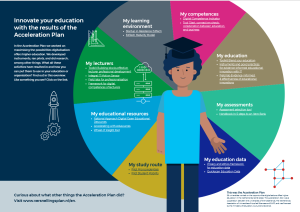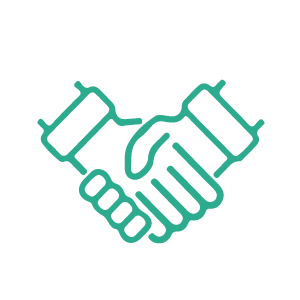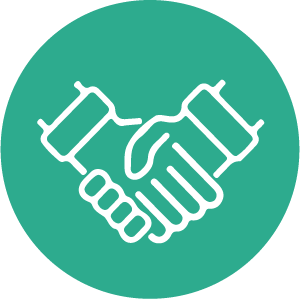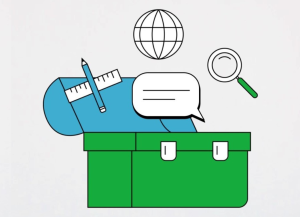
Infographic results Acceleration Plan
In the Acceleration Plan we worked on maximising the possibilities digitalisation offers higher education. We developed instruments, ran pilots, and did research, among other things.
Acceleration plan | Learning Community Tool

How can collaboration between companies and educational institutions be shaped in a learning community?
The Strengthening Digital Human Capital zone has researched this and developed a tool to help you develop or further develop a learning community.
This tool provides practical pointers for the development of a learning community:
1. that combines learning, working and innovating;
2. that is coupled to a concrete innovation question from the business community;
3. where employees, experts, students and lecturers work together;
4. where companies and knowledge institutions mutually benefit from working together in a public-private partnership.
The next step
This tool is a logical follow-up to the Learning community action scan. The action scan gives the community partners insight into the most important aspects of their collaboration, while this tool helps partners to take the next step: to form a learning community around an innovation question from one or more companies. The tool provides practical pointers based on the experiences of multidisciplinary lecturer-researcher teams and research groups in learning community projects.
Target group and aims
The tool has been designed for facilitators, innovators and supervisors who would like to form a learning community:
– in which participants truly learn, work and innovate – together and to solve concrete problems;
– in which employees, students, lecturers and/or experts work together;
– that aims to achieve concrete outcomes, such as a technological or social innovation.
Click on the link below to download the file
> Recommendations and explanations Learning communities
How does it work?
Click on the different tabs and select the recommendations that apply to your learning community. When you have selected all the recommendations, click [View all selected results] to see an explanation and a possible practical example. You can also add your own comments here, related to your specific situation. You can then save the list as a PDF by clicking […]. The recommendations are based on practical experiences from Learning community projects.
The tool has three components:
1. Start: identify the theme of the learning community and the structure of the partnership
2. Design: determine how the learning community will be structured and organised and how the community members will collaborate
3. Implement: organise supervision, working methods and activities in the learning community
In recent years, the Human capital zone has been investigating the cooperation between educational institutions and companies in learning communities. In this environment, students, teachers and the professional field work together on innovation issues. This led to a practical tool for better cooperation between education and business, the Learning Community tool. Want to know more? Go to the page on hybrid learning communities (Dutch).
Share this page

In the Acceleration Plan we worked on maximising the possibilities digitalisation offers higher education. We developed instruments, ran pilots, and did research, among other things.

Getting started with the (continued) development of a powerful learning community How can collaboration between companies and educational institutions be shaped in a learning community?

Integrate digital competences into profiles for (higher) education and work Does a nurse know how to handle his patient’s electronic record? And can a farmer

Blended learning. A concept that is high on the agenda in education land. Are you working on blended learning within your institution? Then you know
Deze website maakt gebruik van cookies. Lees hier over onze Coookies